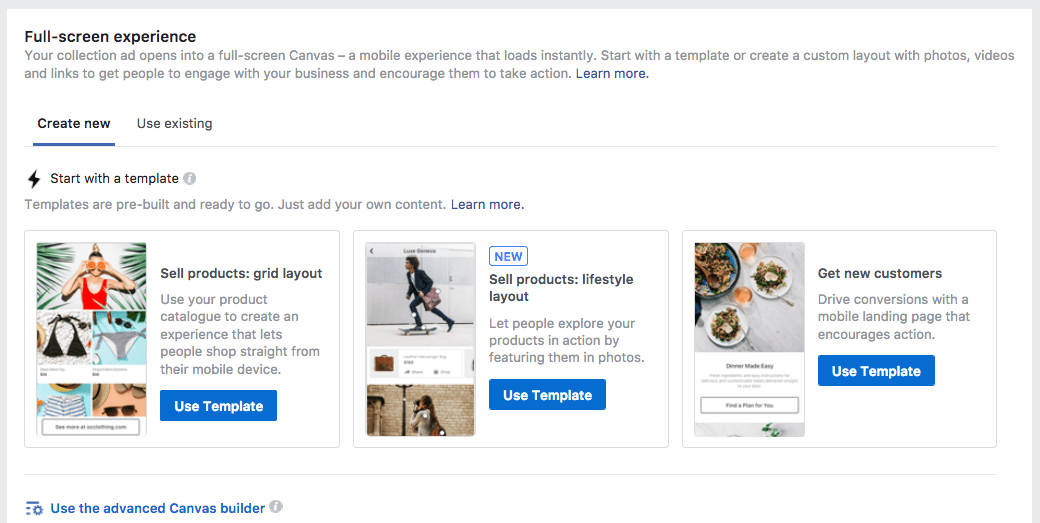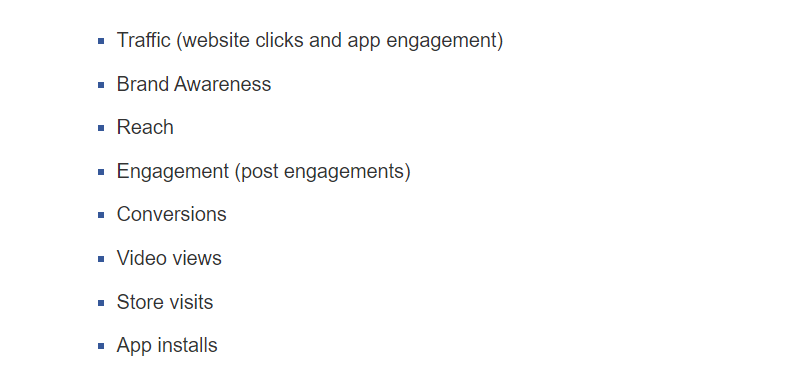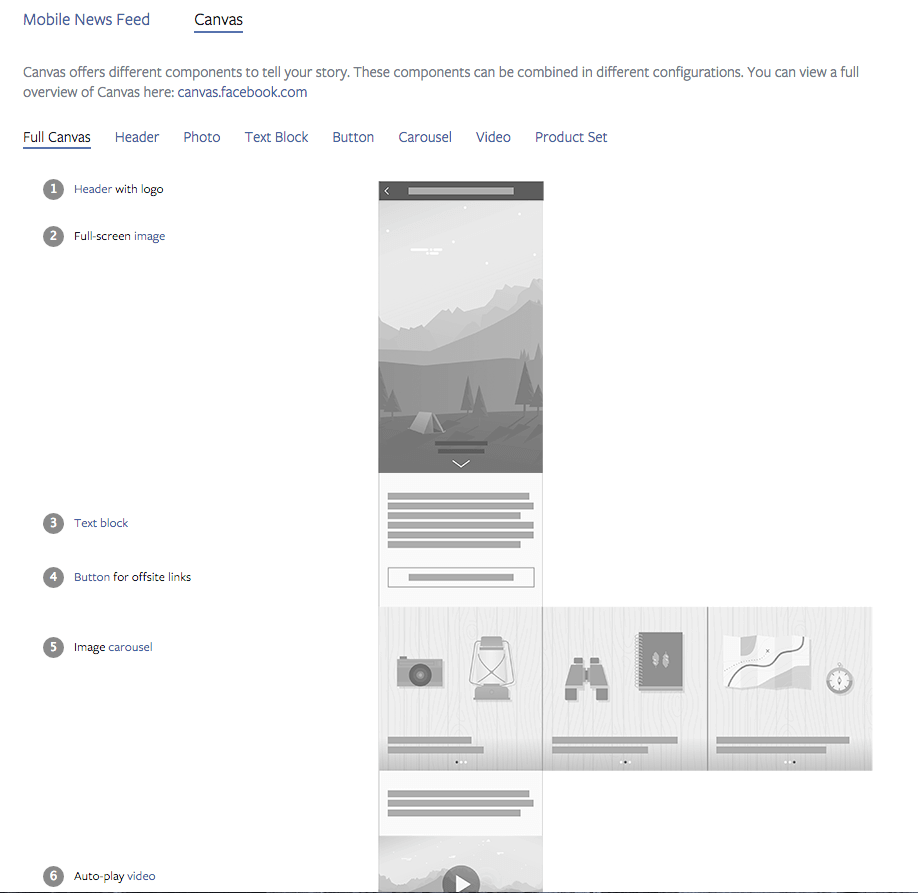
If you’re an advertiser on Facebook, you probably know that Facebook Canvas ads are all about creating immersive experiences. Facebook released Canvas ads back in February of 2016 to solve two common quandaries.
First, websites to which traditional Facebook ad types redirected could be slow to load, and were not always optimized for mobile—which, according to Facebook, were two of the top reasons users might abandon said websites. Second, it was difficult for brands to tell deep, compelling brand stories on mobile using traditional ad types. There just wasn’t enough space. There just wasn’t enough functionality.
Enter Canvas Ads. Glorious.
In this post, we’re going to give you the skinny on Facebook Canvas ads—including how they work, and how to make one yourself. Then, to give you an idea of how to effectively create Canvas ads for your business, we’re going to show you examples of Canvas ads for three common Facebook ad objectives—customer acquisition, eCommerce, and brand building—and discuss why each ad works to accomplish its ascribed objective.
Let’s check out some Facebook Canvas ad examples.
What Are Facebook Canvas Ads?
The above Canvas ad from Carnival Cruise Line is sort of the seminal example of the ad type you’ll see around the web. And Canvas ads have come a long way in the last couple years. Still, you can see the immediate benefits of the format in that brief snapshot. Canvas ads give advertisers the ability to invite prospects into their brands’ worlds—what exactly would users be in for if they were to purchase this product/interact meaningfully with this business?
If you’re thinking about using Canvas ads in your next campaign, your target audience is, at the very least, “in for” this: speed and usability.
Because the user experience takes place directly within Facebook News Feed and not on an outside landing page, it loads nearly instantaneously. Once the user is interacting with the Canvas, he/she can easily navigate through a wide range of multimedia—whether it’s swiping through a carousel of products, tilting to view panoramas, zooming in to view images in detail, or pressing pristine call-to-action buttons.
When done well, the experience can be truly engaging: Facebook claims 53% of users that open a Canvas ad view at least half of it, and the average view time per ad is an impressive 31 seconds.
Now: crafting an ad that combines images, videos, text, CTAs, and DVDs might seem like more trouble than it’s worth. Not sure you have the technical chops? Facebook has made the creation process quite easy.
How to Create a Facebook Canvas Ad
It’s all about templates.
Like, say, creating a Squarespace website, creating a Facebook Canvas ad is an uber-templated process—if you want it to be. You do have the option to create your own Canvas template, if you’d like—but more likely, you’re interested in getting your immersive ad out into the wild as quickly and efficiently as possible.
If that is indeed the case, you have four templates to choose from:
- Get new customers: Best for customer acquisition and lead generation. Funnels prospects to subscriptions, sign-ups, and checkout pages within your Canvas.
- Sell products: Lifestyle Layout: Best for eCommerce. Allows shoppers to explore products featured in lifestyle images.
- Sell products: Grid Layout: Best when paired with catalogs and large (more than 50) product sets.
- Showcase your business: Best for expanding your reach, driving brand awareness, and building brand affinity.
The template you choose will depend upon your objective. The Canvas ad format is available for each of the following objectives:
Once you’ve decided upon your objective and selected a template, the creation process is a matter of dragging and dropping within Ads Manager.
Image via AdEspresso
For more information on Canvas creation, Facebook has compiled a useful set of resources here.
With that in mind, let’s take a look at some examples of each of these templates in action and discuss how they work to provide objective-based business value.
Ecommerce Canvas Ads
Are conversions your main objective? The following ad from Mr. Porter was tailor-made to sell online products. You can achieve a similar aesthetic to this ad by using the Lifestyle Layout of the Sell Products template.
Mr. Porter leverages the power of lifestyle
The immediate benefits of the Lifestyle Layout make themselves evident here. Seeing a brand’s products in action is massively appealing to a consumer—mostly, because it lends the product some measure of credibility, and allows the consumer to envision what he would look like wearing/using the product in his own life.
You see the same sort of selling credibility lent to products promoted by social influencers—49% of consumers rely on product recommendations shared by influencers for their purchases. While clothing models aren’t influencers, they achieve a similar impact on the buyer—they allow him to associate the product with the happiness/fulfillment/what-have-you he feels when he looks at the influencer or model.
The clean, provocative lead image—combined with the incisive call-to-action—does a lot of the initial work here. An immersive video bridges the gap between lead image/copy and products.
From there, Mr. Porter segments its products by category with a single image, some sparse copy, a carousel of products, and a call to action. You’ll notice that for the most part, the carousel products reflect the products worn in the images above. Because there’s no landing page, the user need merely scroll and select the products he identified with in the image—all within the Canvas.
In no other ad format can you achieve that level of immediacy. It makes Canvases a powerful option for eCommerce advertisers.
Customer Acquisition Canvas Ads
Are subscriptions, sign ups, and contact information your game? The below ad from American Express is a great example of a brand leveraging a Canvas for customer acquisition/lead generation.
American Express sells freedom and autonomy
A lot of small businesses out there don’t have the time or resources to create engaging video content. While American Express does have those resources, this ad is a good example of the fact that you don’t need video content to create an engaging Canvas.
Aided by animated text and pristine imagery, this “choose your own adventure” style of storytelling evokes strong feelings of freedom and autonomy. Users can navigate wherever they want in this ad. Perhaps by purchasing the product, they can navigate wherever they want in their lives, as long as the IRS is cool with it.
You’ll notice that there’s only one call-to-action in this ad, and it comes in the final panel of the Canvas. The first several panels serve to immerse the customer in the brand experience without asking anything of her. Instead of call-to-actions, the animated text describes all the ostensible benefits of the product—tells the product story.
Effective customer acquisition Canvases strike that healthy balance between brand building and selling. These prospects are still in the “consideration” phase of the buyer journey—they need to be nurtured before making a purchase. Take the time to show them how your product can enrich their lives.
Brand Building Canvas Ads
If you’re trying to generate awareness for your business or accrue general website traffic, Canvas ads are a great option. The following is a Canvas ad from Ocean Basket which harps on storytelling over selling, and invites prospects to learn more.
Ocean Basket: Meet the Sushi Master
South Africa’s Ocean Basket created the above campaign as a means of introducing potential customers to its “Coriander Bomb” maki roll—or, more accurately, to its brand as a whole. The question in the lead image— “What happens when two worlds collide?”—evokes curiosity and sets the tone for the spot: this ad is trying to tell you something interesting first; sell you something second. The second panel, which leads into the video content, comes replete a with a call-to-action which also reflects the friendly, informational tone of the spot. “Meet the Sushi Master” is a way of introducing prospects to the Ocean Basket brand, and engraining within them the story Ocean Basket wants told.
This is a story about a sweet man bun. More so, though, it’s a story about transparency, and it’s told in a linear fashion.
We’re given the chef’s name and the credibility of his background. We’re given the “what makes our business unique” statement—this business combines Mediterranean and Asian cuisine. After seeing ingredients fly cavalier across the screen, we’re invited to explore them ourselves—this is the food in its essence, the nuts and bolts of the dish. In the last panel, we’re graced with the product itself, Chef Pepi’s grinning mug, and a quick scroll-down to the call-to-action: “View More.” Though it’s product-centric, this is not an advertisement for sushi. It’s an advertisement for a business. Focusing solely on storytelling and eschewing product-pushing is a tried-and-true way to generate awareness of and affinity for your brand.
Crafting a Facebook Canvas Ad to Fit Your Campaign
Facebook Canvas ads are a good example of that old adage, “You get out what you put in.”
While Canvas ads are undoubtedly more time-consuming than other ad types to create, they also offer a far more dynamic and interactive user experience. Think about the feeling you’d evoke in prospects if you could immerse them in an ideal situation with your brand or product. With careful curation, Canvas ads give you the ability to evoke that feeling.










